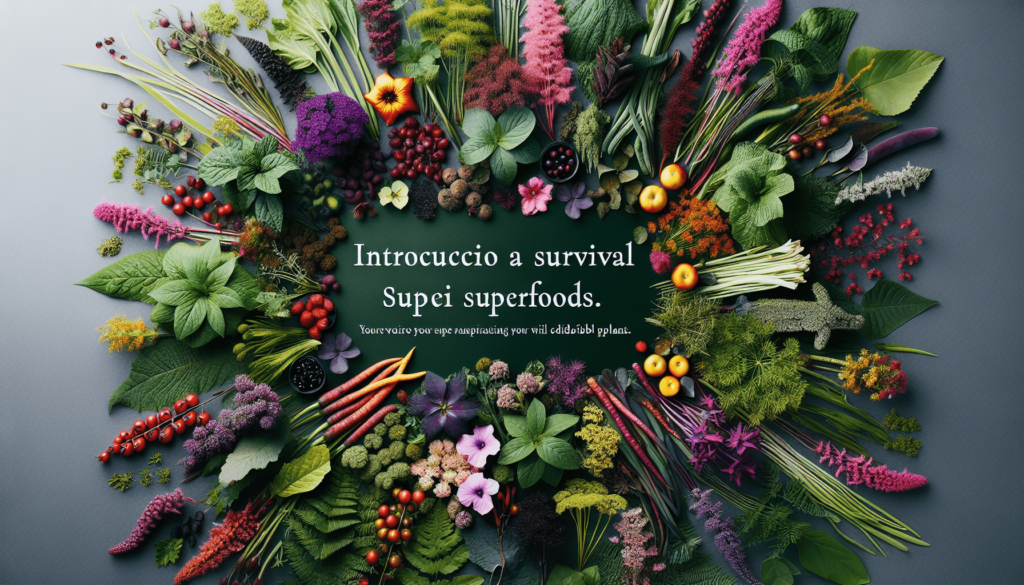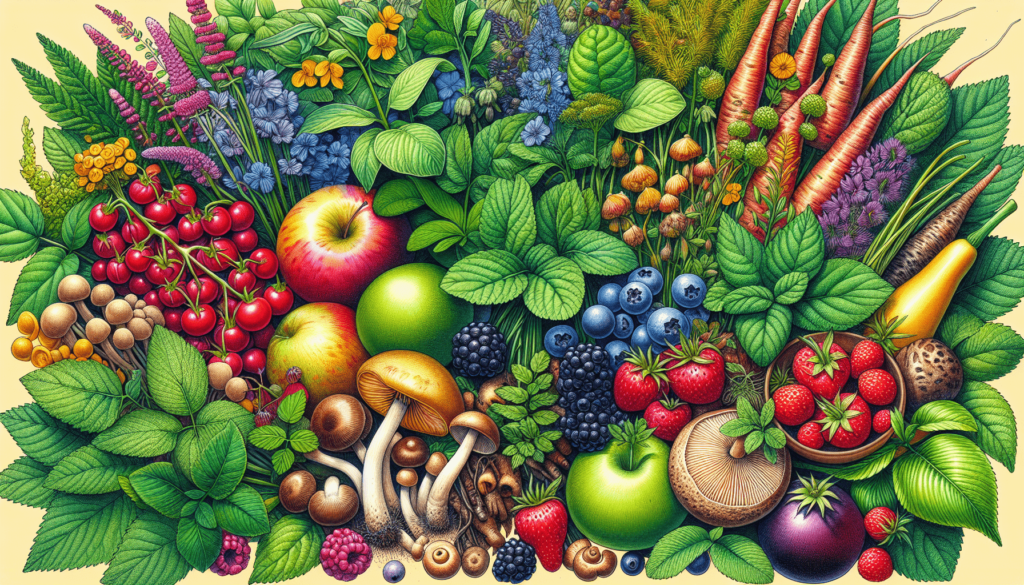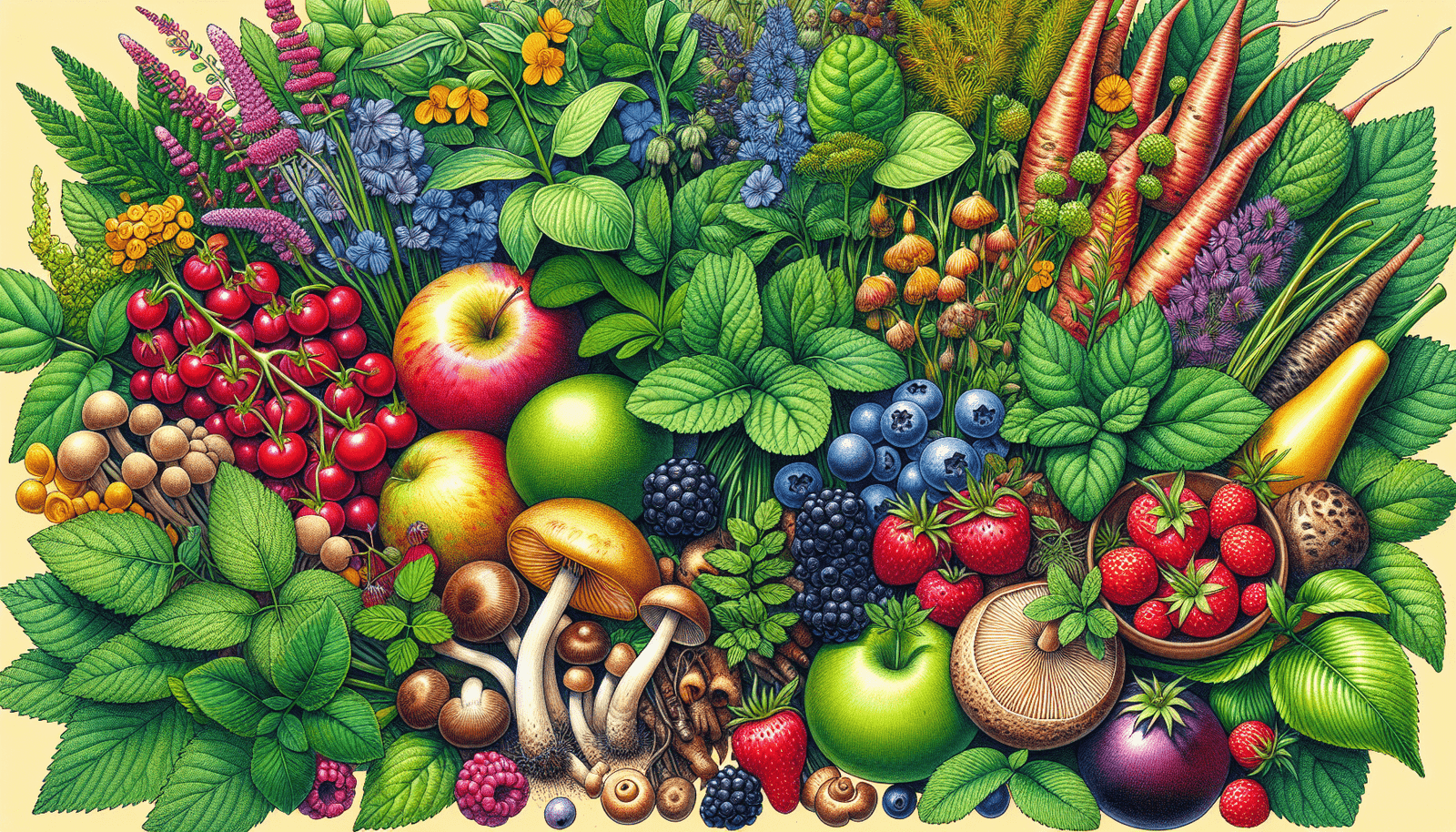In the wild, where resources are scarce, knowing which plants to forage for food can be a game-changer. That’s why in my latest article, “Survival Superfoods: Top wild edibles for Maximum Nutrition,” I’ve compiled a list of some of the most nutrient-rich and easily accessible wild edibles that can sustain you in any wilderness situation. From the tart and tangy rosehips to the protein-packed cattail shoots, these superfoods not only provide vital nutrients but also add a tasty twist to your survival meals. So, whether you’re planning an adventure or simply interested in expanding your knowledge, get ready to discover the ultimate wild pantry that nature has to offer.
Introduction to survival superfoods
Welcome to “The Survivalist Handbook”! In this article, we will be exploring the world of survival superfoods, specifically focusing on wild edibles that can provide you with maximum nutrition in a wilderness situation. When you’re out in the wild, knowing which foods you can forage for sustenance is crucial for your survival.
Importance of wild edibles for maximum nutrition
In a survival situation, wild edibles play a pivotal role in providing you with the necessary sustenance to thrive. While it is always ideal to have a well-stocked supply of food, circumstances may arise where you have to rely solely on the resources available in the surrounding environment. That’s where wild edibles come into play, offering a rich source of nutrients, vitamins, and minerals. By incorporating these foods into your survival plan, you can ensure that you are nourishing your body and maximizing your chances of survival.
Wild berries
Berries are not only delicious but also packed with essential nutrients. In the wild, you can find a variety of wild berries that can provide a significant boost to your nutrition. From the succulent and tangy taste of blackberries to the sweet and vibrant hues of raspberries, these little gems are a great source of vitamins, antioxidants, and fiber. Consuming wild berries can improve your immune system, aid digestion, and even promote healthy skin.
Leafy greens
Leafy greens are another group of wild edibles that offer a range of nutritional benefits. These greens are not only abundant in the wild but also contain high levels of vitamins A, C, and K, as well as minerals like iron and calcium. The consumption of leafy greens can help strengthen your bones, boost your energy levels, and improve your overall well-being. Examples of common edible leafy greens in the wild include dandelion greens, lamb’s quarters, and plantain leaves.
Root vegetables
Root vegetables are an excellent source of carbohydrates, vitamins, and minerals, making them highly valuable in a survival situation. These wild edibles can provide sustenance and energy, ensuring your body has the fuel it needs to endure challenging circumstances. Common examples of edible root vegetables in the wild include wild carrots, wild onions, and wild garlic. However, proper identification and safe harvesting techniques are essential when it comes to root vegetables, as some plants may have toxic look-alikes.
Edible flowers
Incorporating edible flowers into your survival plan can not only provide aesthetic appeal to your meals but also offer various nutritional benefits. Edible flowers contain antioxidants, vitamins, and minerals that can support your overall health. Popular examples of edible flowers in the wild include violets, daisies, and dandelions. With their delicate flavors and vibrant colors, these flowers can uplift both your spirit and your palate in a survival situation.
Nutritional benefits of wild berries
Wild berries are a powerhouse of nutrition, containing an array of vitamins and antioxidants. They are rich in vitamin C, which boosts your immune system, and antioxidants like anthocyanins, which protect against cell damage. The high fiber content in wild berries aids digestion and can help regulate blood sugar levels. Additionally, these berries are low in calories, making them an excellent option for those looking to maintain a healthy weight.
Different types of wild berries
There is a wide variety of wild berries you can discover in the wilderness. Some common types include blackberries, raspberries, blueberries, strawberries, and gooseberries. Each of these berries has its unique flavor profile and nutritional composition. By diversifying the types of wild berries you consume, you can benefit from a range of nutrients and antioxidants.

How to identify and harvest wild berries
When foraging for wild berries, it is crucial to correctly identify the plants to ensure you are consuming safe and edible options. A comprehensive field guide can be an invaluable resource as it will provide you with detailed descriptions and images of various wild berries. Additionally, learning about the specific characteristics, growth patterns, and habitats of these berries can aid in their correct identification. Once you have identified the berries, remember to harvest them responsibly, ensuring you leave enough behind for both wildlife and future foragers.
Nutritional benefits of leafy greens
Leafy greens are a nutritional powerhouse, dense in vitamins, minerals, and fiber. They are particularly rich in vitamin A, which promotes healthy vision and immune function. Leafy greens are also abundant in vitamin C, which aids the absorption of iron and maintains healthy skin. Incorporating leafy greens into your diet during a survival situation can provide you with essential nutrients necessary for your overall health and well-being.
Common edible leafy greens in the wild
In the wilderness, several common leafy greens can be foraged for consumption. Dandelion greens, known for their slightly bitter taste, are packed with vitamins A, C, and K. Lamb’s quarters, often referred to as “wild spinach,” offer a mild and earthy flavor while providing high levels of calcium and vitamin C. Plantain leaves, not to be confused with the fruit, are rich in iron and can be used in salads or cooked as greens. By knowing which leafy greens are safe to consume, you can take advantage of the abundant resources provided by nature.
Preparation methods for leafy greens
Once you have successfully foraged for edible leafy greens, it is essential to clean and cook them properly to eliminate any potential contaminants and to enhance their flavors. Thoroughly washing the greens with clean water can remove dirt, insects, or other impurities. You can then prepare them by blanching, sautéing, or adding them to soups and stews. Experimenting with different cooking methods can help you find your preferred flavors and textures.
Nutritional benefits of root vegetables
Root vegetables are packed with essential nutrients, making them a valuable source of sustenance in a survival situation. They are high in carbohydrates, which provide energy, and contain vitamins, minerals, and fiber. Root vegetables can promote healthy digestion, support immune function, and contribute to overall well-being. Incorporating these wild edibles into your diet can ensure that you are receiving a well-rounded nutritional profile.
Common edible root vegetables in the wild
When it comes to consuming root vegetables in the wild, it is important to be able to distinguish between edible species and their potentially toxic counterparts. Some examples of common edible root vegetables include wild carrots, which are rich in vitamin A and can be consumed raw or cooked. Wild onions, with their distinct, pungent flavor, contain antioxidants and can be a flavorful addition to meals. Wild garlic, known for its strong aroma, offers various health benefits and can be used similarly to domesticated garlic. Always ensure proper identification before consuming any wild root vegetables.
Safe harvesting and preparation of root vegetables
To safely harvest and prepare root vegetables, it is crucial to be well-informed about proper techniques. When harvesting, use a digging tool to carefully extract the vegetables from the ground, ensuring minimal damage to the plant and the surrounding environment. Once harvested, thoroughly clean the vegetables to remove any dirt or debris. Depending on the specific vegetable, you can consume them raw or cooked. Boiling, roasting, or grilling are common preparation methods for root vegetables.
Nutritional benefits of edible flowers
Edible flowers offer not only a visually appealing addition to your meals but also a range of nutritional benefits. They are rich in vitamins, minerals, and antioxidants, which can support your overall health. Incorporating edible flowers into your survival diet can provide an additional source of essential nutrients, such as vitamin C and beta-carotene. These flowers also have a positive impact on mental well-being, as their vibrant colors can uplift your mood and boost morale in a challenging situation.

Popular edible flowers in the wild
Discovering the world of edible flowers in the wild can be an exciting and rewarding experience. Violets, with their delicate purple petals, are not only visually captivating but also contain antioxidants and vitamin C. Daisies, with their vibrant yellow centers and white petals, can be used as a garnish or steeped as a herbal tea. Dandelions, commonly found in meadows, offer a variety of culinary possibilities and are known for their diuretic properties. Remember to research and identify edible flowers accurately before consuming them.
Uses of edible flowers in survival situations
Edible flowers can serve multiple purposes in a survival scenario. Apart from being consumed directly, they can be used to infuse water or create herbal teas, providing hydration and flavor. Edible flowers can also be added to soups, salads, or stews to enhance taste, color, and overall visual appeal. By incorporating these floral delicacies into your meals, you can add diversity and nutrition to your survival diet.
Precautions and safety guidelines for foraging wild edibles
While foraging for wild edibles can be an exhilarating experience, there are important precautions and safety guidelines to keep in mind. First and foremost, familiarize yourself with toxic and poisonous plants in your area to minimize the risk of consumption. Ensure proper identification through the use of field guides, reputable resources, and expert advice. Pay attention to plant characteristics, growth patterns, and habitats to avoid any potential mix-ups. Lastly, assess the quality of the environment and avoid foraging near polluted or contaminated areas.
Avoiding poisonous plants
One of the most critical aspects of foraging wild edibles is staying away from poisonous plants. To avoid accidental consumption, learn to recognize common toxic plant species that may closely resemble edible plants. Some notable examples include poison hemlock, which resembles wild carrots, and false morel mushrooms, which can be mistaken for edible morel mushrooms. Educating yourself on these toxic plants can be a lifesaving measure when it comes to survival foraging.
Proper identification and assessment
Proper identification and assessment are crucial when foraging for wild edibles. Utilize reliable field guides and reputable resources to help you accurately identify edible plants. Take note of distinctive features, such as leaf shape, color, and texture, as well as the plant’s growth pattern and any accompanying flowers or fruit. Assess the overall health of the plant and avoid harvesting if there are signs of decay, pest infestation, or other abnormalities. By being diligent in your identification and assessment, you can reduce the risk of consuming harmful plants.
Sustainable foraging practices
When foraging for wild edibles, it is essential to employ sustainable practices to ensure the preservation of natural resources. Only harvest what is needed and leave behind a healthy population of plants for future foragers and wildlife. Avoid damaging the surrounding environment while harvesting and be mindful of fragile ecosystems. By practicing sustainability, you can enjoy the benefits of foraging while preserving the natural balance of the wilderness.
Responsible harvesting techniques
Responsible harvesting techniques are vital to maintain the sustainability of wild edibles. When harvesting, take only what is necessary and never strip an entire plant or population. Ensure that plants have had sufficient time to reproduce and propagate before harvesting their edible parts. If possible, harvest in a rotating manner, allowing different areas to recover while you move on to new locations. By being responsible in your harvesting practices, you can contribute to the long-term availability of these valuable resources.
Preserving and storing wild edibles
Preserving and storing wild edibles is essential for long-term use and to avoid wastage. Some wild edibles can be dried or dehydrated to prolong their shelf life, while others can be pickled or fermented. Properly stored wild edibles can serve as a valuable food source during times of scarcity or when fresh options are limited. In a survival situation, knowing how to effectively preserve and store wild edibles can be the key to sustaining yourself for an extended period.
Cooking and recipes with wild edibles
Incorporating wild edibles into your cooking can introduce exciting flavors and create a diverse range of meals. From salads and soups to stir-fries and stews, the possibilities are endless. Experimenting with different cooking methods and flavor combinations can turn survival meals into delicious and satisfying endeavors. By embracing the versatility of wild edibles, you can elevate your survival cuisine and make the most of the resources available to you.
Creative ways to incorporate wild edibles into meals
Get creative with how you incorporate wild edibles into your meals. Add wild berries to oatmeal or pancakes for a burst of natural sweetness. Combine leafy greens with other foraged vegetables to create nutrient-packed salads. Mix root vegetables with wild game or fish for hearty stews. Infuse edible flowers into herbal teas or use them as a natural garnish. By thinking outside the box and embracing the unique flavors of wild edibles, you can create memorable and nourishing meals even in challenging circumstances.
Nutritious and delicious survival superfood recipes
Here are a few nutritious and delicious survival superfood recipes to inspire you in your culinary adventures:
-
Wild Berry Overnight Oats: Combine rolled oats, almond milk, chia seeds, and a handful of wild berries in a jar. Leave it overnight in the fridge, and in the morning, you’ll have a nutrient-packed breakfast ready to enjoy.
-
Dandelion Green Salad: Toss dandelion greens with lemon juice, olive oil, garlic, and a sprinkle of salt and pepper. Add some toasted nuts or seeds for extra crunch and protein.
-
Roasted Root Vegetable Medley: Chop a mix of wild carrots, wild onions, and wild garlic into bite-sized pieces. Toss with olive oil, salt, and your favorite herbs. Roast in the oven until the vegetables are tender and slightly caramelized.
-
Violet Lemonade: Steep fresh violet flowers in a glass of cold water for several hours. Once infused, strain the flowers and add lemon juice and sweetener to taste. Serve over ice for a refreshing and floral beverage.
Feel free to modify these recipes based on the wild edibles available to you and your personal preferences. The key is to get creative and have fun exploring the flavors of the wilderness.
Conclusion
In conclusion, survival superfoods in the form of wild edibles can provide you with maximum nutrition in a wilderness situation. Understanding the nutritional benefits and identification techniques for wild berries, leafy greens, root vegetables, and edible flowers is crucial to optimizing your survival diet. By incorporating these wild edibles into your meals, you can ensure that you are fueling your body with the necessary nutrients to thrive in challenging circumstances. Remember to always forage responsibly and prioritize safety when it comes to identifying and harvesting wild edibles. With the right knowledge and resources, you can turn survival foraging into a rewarding and nourishing experience. Stay safe, stay prepared, and continue exploring the vast world of survival superfoods.

